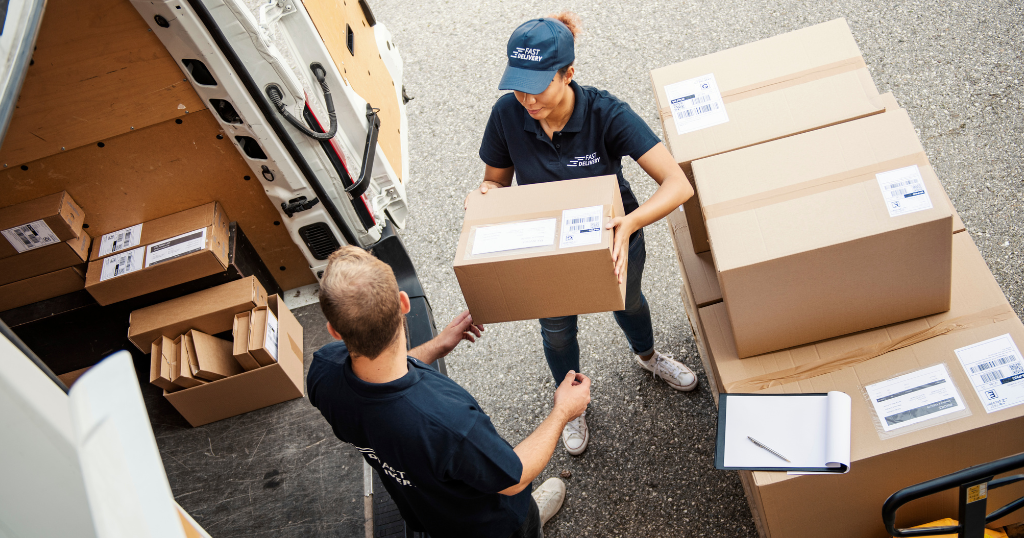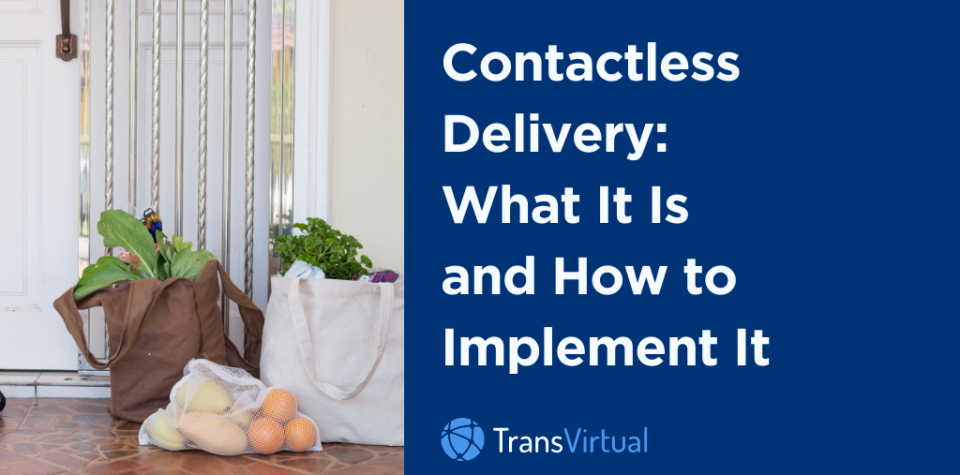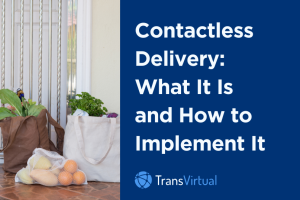Table of Contents
COVID-19 brought a safety risk to both the customer and delivery drivers alike.
But the pandemic also brought some good news for logistics companies. It led to a delivery boom, requiring more drivers to be at more doors each day.
It also popularized contactless delivery, offering a safer and more efficient way to meet demand. The benefits of contactless delivery is increasingly clear.
You speed up your deliveries, they’ll feel less stressful, and you’ll lower costs all round, all while adapting to the necessary contactless delivery options consumers demand today.
So if you’re thinking of adding a contactless delivery option for your business, you’ve come to the right place. Here are tips to get started.
What is Contactless Delivery?
Contactless delivery, also known as no contact delivery, is pretty self-explanatory. It’s a delivery method where the driver and consumer have no physical contact at the doorstep, ensuring that goods and services are delivered safely and conveniently.
What started in response to safety concerns over COVID-19 transmission is quickly becoming the new standard in delivery.
According to Deloitte, the demand for contactless (and on-time) deliveries is expected to grow in time. In fact, most food delivery apps offer contactless delivery options.
To provide efficient contactless deliveries, you need to allow digital payments, leverage delivery software, and incorporate contactless delivery policies.
Benefits of Contactless Delivery
No contact delivery offers several benefits, including the following:
Safety and Sanitation
Incorporating contactless delivery, where the delivery driver leaves the package at the customer’s doorstep without any direct, in-person contact, reduces the transmission of infectious diseases.
It also limits the exposure of delivery personnel to contaminated surfaces or environments. By encouraging hygiene practices, such as regular hand washing and sanitizer use, you help drivers lessen the risk of contracting a disease while on the job.
Deliver faster and ensure customer satisfaction
No contact delivery is just faster. You remove the need for physical paperwork or signatures and also reduce wait times at delivery locations.
Seeing delays creep into your run because someone isn’t home is really common. Instead of backtracking to drop the parcel somewhere else, you can simply upload an electronic proof of delivery and off you go.
Faster delivery times also lead to more positive customer feedback. Satisfied customers are more likely to repeat business and may even recommend you to their network, contributing to overall business growth.
Lower costs and go paperless too
Imagine… No more lost paperwork and no more waiting for it to be returned to know what’s happening.
What used to take hours or sometimes even days, is now a matter of taking a photo and adding it to the app. Your delivery management software will then automatically send the photo and GPS coordinates as proof of delivery.
Integrating contactless delivery software enhances this process by enabling paperless operations and improving the contactless delivery experience with features like real-time tracking and contactless proof of delivery.
Digitise and automate your operations
When you leave paper POD behind and track delivery digitally, you improve efficiency and customer confidence. Incorporating contactless delivery technology is crucial in this digital transition, enabling businesses to automate and streamline the contactless delivery process efficiently.
But even more than that, it gives you complete control of your delivery operations.
Investing in the best delivery software enhances your ability to manage fleets and stabilize operations through advanced contactless delivery technology. It means you can streamline and automate your back-end processes, and give your operational staff the tools they need to get the job done efficiently and accurately. 100% visibility is a reality.
Reporting and future planning becomes easy too, with sophisticated data at your fingertips. Use it to inform your decisions.
Impressive, isn’t it? Now let’s look at how you can make all of this possible.
How to Implement Contactless Delivery Technology to Increase Your Bottom Line
COVID-19 brought a safety risk to both the customer and delivery drivers alike.
But the pandemic also brought some good news for logistics companies. It led to a delivery boom, requiring more drivers to be at more doors each day.
It also popularized contactless delivery, offering a safer and more efficient way to meet demand. The benefits of contactless delivery is increasingly clear.
You speed up your deliveries, they’ll feel less stressful, and you’ll lower costs all round, all while adapting to the necessary contactless delivery options consumers demand today.
So if you’re thinking of adding a contactless delivery option for your business, you’ve come to the right place. Here are tips to get started.
What is Contactless Delivery?
Contactless delivery, also known as no contact delivery, is pretty self-explanatory. It’s a delivery method where the driver and consumer have no physical contact at the doorstep, ensuring that goods and services are delivered safely and conveniently.
What started in response to safety concerns over COVID-19 transmission is quickly becoming the new standard in delivery.
According to Deloitte, the demand for contactless (and on-time) deliveries is expected to grow in time. In fact, most food delivery apps offer contactless delivery options.
To provide efficient contactless deliveries, you need to allow digital payments, leverage delivery software, and incorporate contactless delivery policies.
Benefits of Contactless Delivery
No contact delivery offers several benefits, including the following:
Safety and Sanitation
Incorporating contactless delivery, where the delivery driver leaves the package at the customer’s doorstep without any direct, in-person contact, reduces the transmission of infectious diseases.
It also limits the exposure of delivery personnel to contaminated surfaces or environments. By encouraging hygiene practices, such as regular hand washing and sanitizer use, you help drivers lessen the risk of contracting a disease while on the job.
Deliver faster and ensure customer satisfaction
No contact delivery is just faster. You remove the need for physical paperwork or signatures and also reduce wait times at delivery locations.
Seeing delays creep into your run because someone isn’t home is really common. Instead of backtracking to drop the parcel somewhere else, you can simply upload an electronic proof of delivery and off you go.
Faster delivery times also lead to more positive customer feedback. Satisfied customers are more likely to repeat business and may even recommend you to their network, contributing to overall business growth.
Lower costs and go paperless too
Imagine… No more lost paperwork and no more waiting for it to be returned to know what’s happening.
What used to take hours or sometimes even days, is now a matter of taking a photo and adding it to the app. Your delivery management software will then automatically send the photo and GPS coordinates as proof of delivery.
Integrating contactless delivery software enhances this process by enabling paperless operations and improving the contactless delivery experience with features like real-time tracking and contactless proof of delivery.
Digitise and automate your operations
When you leave paper POD behind and track delivery digitally, you improve efficiency and customer confidence. Incorporating contactless delivery technology is crucial in this digital transition, enabling businesses to automate and streamline the contactless delivery process efficiently.
But even more than that, it gives you complete control of your delivery operations.
Investing in the best delivery software enhances your ability to manage fleets and stabilize operations through advanced contactless delivery technology. It means you can streamline and automate your back-end processes, and give your operational staff the tools they need to get the job done efficiently and accurately. 100% visibility is a reality.
Reporting and future planning becomes easy too, with sophisticated data at your fingertips. Use it to inform your decisions.
Impressive, isn’t it? Now let’s look at how you can make all of this possible.
How to Implement Contactless Delivery Technology to Increase Your Bottom Line

You can’t make contactless delivery work without technology. You need a system that is capable of managing orders, dispatch, and delivery without the need for physical interaction.
We’re going to start at the beginning so you can see how everything is interconnected. We recommend leveraging a transportation management system, as these platforms can assist you from the initial online order to the final doorstep drop-off.
Order and Online Payment Options
To make contactless delivery work, you need a robust ordering and payment system. This setup includes an online ordering system that allows customers to place orders and complete payments entirely online.
It should seamlessly integrate with popular credit/debit cards, mobile wallets, and online banking, ensuring smooth and secure transactions every time.
Transport Management System for Tracking and Routing
1. Scan the day’s deliveries into the system and optimise your routes
If you’re offering contactless delivery services, the first thing you need to do is register orders on the system. Once your orders are in, you should be able to plan and allocate deliveries for the day (and for future deliveries, if your system allows this).
Transport management systems automate the entire delivery process, including route planning. By planning your routes ahead, or dynamically switching routes in case of emergencies or road closures, you ensure timely deliveries and minimise idle times.
2. Use real-time tracking
Once your drivers are on the road, track their progress in real time.
Not only does this mean you always have up-to-date ETAs, but also that you don’t need to interrupt your driver to answer customer enquiries. It’s all there at a glance for your entire team. You can even set up automatic notifications to go out to the consumer based on how the driver is tracking.
3. Send photo proof and electronic POD
Now comes the contactless part. Your driver simply delivers the parcel to the door and takes a photo of it there. Contactless delivery involves the delivery person leaving the package outside the recipient’s doorstep without any physical contact, leveraging technology to notify the customer and confirm delivery.
As soon as your delivery person has uploaded the photo proof into their mobile app, the customer is automatically notified of proof of delivery by email. And again, every step is instantly visible to your dispatch team and other staff who need to know.
You can see this is only possible when you have your system set up so that it’s all connected electronically.
Of course, nothing goes to plan 100% of the time. Sometimes there’ll be mistakes made when loading, or the goods are damaged. Make sure your TMS allows drivers to make notes and take photos of damage or other issues.
Final thoughts
When the pandemic started, going contactless was mostly motivated by safety to avoid transmission. But it’s fast becoming the new standard, so even ignoring COVID-19 concerns, it’s worthwhile getting this set up.
The evolution towards contactless delivery systems reflects a significant shift in how businesses operate, emphasizing the importance of a delivery system that minimizes physical contact.
Offering contactless delivery has become essential, not just for safety but as a response to consumer demand for no-contact transactions in groceries, medical supplies, and more.
Not only will you improve driver and consumer safety, you’ll deliver faster, and lower your costs.
If you have questions or want to talk about how TransVirtual can help you implement contactless delivery, get in touch. Our friendly local support team are here to help.



